Incoming freshmen have been excluded from these previews, as we'd like to wait and see what they have to offer on the NCAA level before we come to any long-term conclusions.
-Top 20 NBA Prospects in the Big Ten
-Top NBA Draft Prospects in the ACC, Part One
(#1) James McAdoo
-Top NBA Draft Prospects in the ACC, Part Two
(#2) C.J. Leslie (Video Scouting Report)
-Top NBA Draft Prospects in the ACC, Part Three
(#3) Mason Plumlee (Video Scouting Report)
-Top NBA Draft Prospects in the ACC, Part Four
(#4) Alex Len
(#5) Michael Snaer
#6, Reggie Bullock, 6'7, SG/SF, Junior, North Carolina
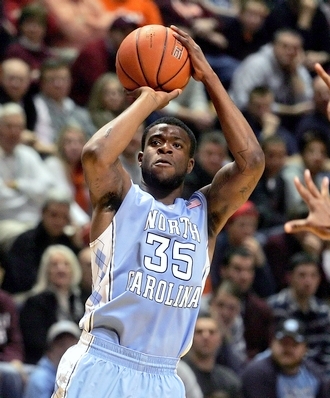
Kyle Nelson
Reggie Bullock has been talked about in recruiting circles from a very young age, and made his first appearance on DraftExpress as a sophomore in 2007 en route to a five-star ranking and the McDonald's All-American game. Since arriving at North Carolina, however, Bullock's progress has been slower than expected. After an injury-plagued freshman season, Bullock moved into the starting lineup, replacing an injured Dexter Strickland, and provided the Tar Heels with perimeter scoring and defense, while contributing in a major way during their run to the Elite Eight. With Harrison Barnes now in the NBA, North Carolina will look to Bullock to pick up the slack as a primary scoring option on the wing.
Standing 6'7 with a solid 207-pound frame, Bullock possesses ideal size for a NBA wing player. He is a smooth athlete, as well, quick in the open floor even if he just has average explosiveness around the basket. His role as a spot up shooter afforded him few opportunities to use his size and athleticism to his advantage, making it largely unknown just how good of a ball-handler he is in transition and attacking the basket in the half court.
On offense, Bullock was largely relegated to the role of a 3-point shooter, where he saw nearly two-thirds of his overall field goal attempts last season. He increased his shooting efficiency across the board, making 51% of his 2-pointers, 38% of his 3s, and 73% of his free throws. That being said, his 12.6 points per 40 minutes pace adjusted ranked him as one of the least prolific scorers in our top-100, showing just how limited his role was last year.
It's not surprising, then, that Bullock's best attribute on offense is his silky smooth shooting stroke. While he was a prolific shooter as a freshman, he took a giant step forward as a sophomore. He is primarily a spot-up shooter, thriving alongside point guard Kendall Marshall, running off screens, and knocking down open looks with his feet set. His size and excellent mechanics, particularly his quick release, position him well as a shooter in the NCAA and should benefit him at the next level as well. With North Carolina's entire starting lineup besides him off to the NBA now, it will be interesting to see how his shooting evolves this season, particularly without the assistance of the best passing point guard in college basketball.
While he is not the most versatile offensive player, Bullock showed the ability to put the ball on the floor and create opportunities from mid-range in very small doses. Possessing below average ball-handling skills, and not much of a left hand, Bullock occasionally used his size and strength to bully his way to the basket where he was a solid finisher. That being said, he attempted just 3.9 2-point attempts and 0.8 free throws attempts per 40 minutes pace adjusted, which are both the fewest of any prospect in our pre-season Top-100, showing just how reliant he was on his outside shot last year. As he prepares for his junior season, Bullock will surely be asked to be more aggressive looking to create his own shot more frequently, focusing on attacking his basket, drawing fouls and finding opportunities inside of the arc.
On the other end of the floor, Bullock was an excellent defensive presence as a sophomore, showing the ability to lock down some of the nation's most potent perimeter scorers. He is very quick laterally, capable of guarding all three perimeter positions, and does not give up on plays after he is beaten. While he does not possess a huge wingspan, he is nonetheless able to do an excellent job crashing the glass, particularly on the offensive end where he truly excelled.
Reggie Bullock was not an immediate impact player in Chapel Hill, which is understandable when considering the amount of talent that was around him his first two seasons. According to reports, he evidently worked on his conditioning and offensive game over the summer and scouts will be watching to see if his improvement translates into increased production in one of the nation's highest-octane offenses. North Carolina will be looking for someone to replace Harrison Barnes's production and Bullock will have every opportunity to step into the role. There is clearly a demand in today's NBA for strong, athletic wing players who can shoot and defend at an elite level. Everything is in place for a breakout season. Now it's time to see if he's capable of capitalizing.
#7, Lorenzo Brown, 6-4, PG/SG, Junior, North Carolina State
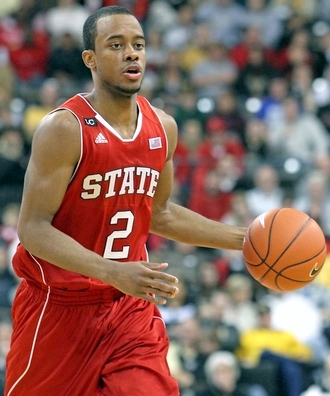
Joe Treutlein
Following a solid freshman season on an underachieving team, Lorenzo Brown made notable improvements in his second year while also helping his team make the Sweet Sixteen. Brown saw slight increases in his two-point percentage, three-point percentage, and free-throw percentage, while also seeing his pace-adjusted assists and points per 40 minutes increase, showing progress in nearly all areas of the game.
On the court, Brown's profile remains largely similar to our previous reports, though he's made subtle changes in a few areas of his game to help take it to the next level.
Brown's improved shooting is the most noteworthy development to his game, and likely the most important for his potential success at the next level. We profiled last year his horrible 20% conversion rate on off the dribble jumpers according to Synergy Sports Technology, and he's seen that number rise considerably to 33% this season. His catch-and-shoot numbers have similarly improved, jumping from 1.0 points per shot as a freshman to a very good 1.259 points per shot as a sophomore.
In terms of his struggles around the basket, Brown's progress is more of a mixed bag, as he still shows considerable problems finishing at the basket in the half court with his slight frame. He's compensated for this somewhat in two ways, however, most importantly by looking a little more willing to draw contact, seeing his free throw attempts rise. He also shows flashes of impressive ability with his finesse lay-ups and floaters in the lane, but this area will likely always remain somewhat a weakness for him, especially if he were to face bigger, more athletic help defenders at the next level.
Most importantly for Brown, he didn't fail to impress in his first collegiate season as the full-time point guard, seeing a strong uptick in his pace-adjusted assists, albeit along with a slightly lower corresponding uptick in his turnovers. Brown shows an excellent command of the game with the ball in his hands, being very impressive with both his passing and ball-handling. He's capable of making the full array of passes in the half court and transition, and frequently mixes in a good combination of both simple passes to open shooters in the flow of the offense and the ability to drive-and-dish in the lane with either hand.
Defensively, Brown continues to be inconsistent and has considerable room to improve, as despite showing solid lateral quickness and the ability to play strong defense in bursts, he frequently lets up from plays, not consistently staying in his stance and moving his feet to stay in front of his man. His lack of great strength and just average quickness will likely leave him at some type of disadvantage against most opponents at the next level, so maximizing his fundamentals and effort level will be key.
Looking forward, Brown needs to continue improving his overall game, most notably his shooting, ability to finish around the basket, and defense, while playing a key role in another winning season with his team would also go a long way for him. He's shown a solid learning curve in his two years on campus, but will have to prove this season his slightly increased numbers as a sophomore weren't just variation, but rather a clear trend of continued improvement with his game. Creative ball-handlers with size and court vision are always in great demand at the professional level, so another strong season could make the NBA a realistic possibility this upcoming spring.
#8, Richard Howell, 6-8, Senior, PF/C, North Carolina State
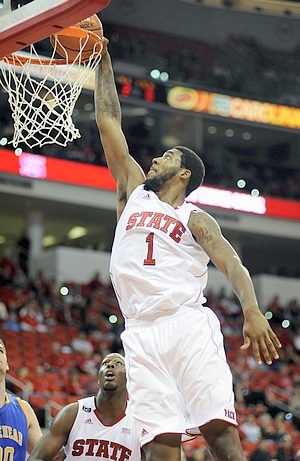
Derek Bodner
After Richard Howell's sophomore season, Howell and incoming N.C. State coach Mark Gottfried made conditioning a priority. Howell came into his junior season having reportedly lost over 20 pounds, and the change was easily recognizable, both in his appearance and his game.
After having averaged 13.6 and 18.2 minutes per game his first two years, the combination of Tracy Smith's graduation and Howell's improved physique allowed his minutes to increase to 27 minutes per game. His per-minute production remained largely the same, averaging 16.0 points and 13.7 rebounds per 40 minutes with the increased time, slightly under the mark of 16.2 points and 14.3 rebounds per 40 minutes during his sophomore season.
Howell's intrigue as a prospect still is largely based on his excellent rebounding ability. Amongst our top 100 prospects, Richard Howell's 5.3 offensive rebounds per 40 minutes ranks as the second best mark. His pursuit on this end of the court is constant, and he has very soft hands. He has an excellent knack for tracking the ball's trajectory, and does a very good job of maintaining control by tipping the ball until he can fully gather it.
N.C. State tried using Howell in more post-up situations this year, without much success. Howell is methodical and deliberate in the post, and his footwork and touch aren't all that advanced either. He has had some success with a hook over his left shoulder, and shows some touch on a turnaround jump shot, but he has yet to establish any comfort using his left hand down low.
As we mentioned when we last profiled him, one of the keys to projecting Howell to the next level would be an increased threat as a jump shooter. He took slightly more jump shots last year, but it's still a relatively minor part of his offensive arsenal. While increasing his attempts, his effectiveness plummeted, from 48.1% on jump shots during his sophomore year to 29.2% last year. Which year is more accurate of his overall potential as a jump shooter is still uncertain, as both years were on very small sample sizes. He overall shows solid form up to mid-range, but extending this and showing consistency are still big steps towards easing concerns going forward.
On the defensive side of the ball is where his improved conditioning might yield the best results. He moved better side to side last year and was lighter on his feet. He's still not incredibly explosive of a leaper, and isn't likely to be much of a shot blocker throughout his career, but if he can show increased lateral mobility it will ease a major concern of his going forward. He has solid strength to defend the post, but he sometimes waits too long in the possession to start denying position. Overall, his focus on this end of the court may be the biggest question mark of his going forward.
Richard Howell still has one undeniable elite skill set that is very much in demand at the NBArebounding--and role players have been able to carve out a niche and stay on rosters due to that skill. The improved conditioning he was in last year was a big step in his maturation as a prospect. If Howell can increase the range and consistency on his jump shot, he can take the next step as a potential NBA prospect.
#9, P.J. Hairston, 6-5, Sophomore, Shooting Guard, North Carolina
Having played a limited role in which he was highly inconsistent as a freshman, we prefer to wait and see how Hairston performs as a sophomore before adding to his scouting report.
#10, Travis McKie, 6-7, Sophomore, Small Forward, Wake Forest
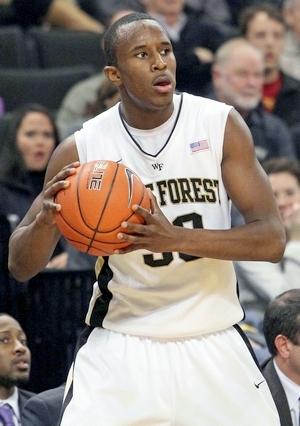
Jonathan Givony
After an impressive freshman season, averaging an efficient 13 points per game as an 18-year old in the ACC, Travis McKie took another important step towards relevance on the national level as a sophomore, finishing sixth in the conference in scoring, again on solid percentages.
Unfortunately for McKie, he did most of his work largely under the radar, on a team that finished a dismal 4-12 in the ACC, tied for last with the only three teams Wake Forest was able to beat in-conference, Virginia Tech, Wake Forest and Boston College.
Measured at 6-6 ½ in shoes with a 6-9 wingspan and a strong 220 pound frame at the Kevin Durant Skills Academy this past summer, McKie has solid size for a NBA wing. He's not an exceptional athlete, but is an intelligent player with good scoring instincts.
A complimentary option in Wake Forest's offense, despite his high usage rate, McKie sees most of his touches working off the ball as a spot-up, post-up or cutting option. He does a good job using screens and finding open spaces to get a high percentage shot off, showing very nice touch finishing around the basket despite not being a high flyer. He's also able to find success operating with his back to the basket, thanks to his strength and scoring instincts. He converted a solid 51% of his 2-point attempts, and got to the free throw line at a solid rate, where he shot 74% once there.
More importantly for his long-term outlook is the fact that he's improved his perimeter shooting since his freshman season, knocking down over one 3-pointer per game last year, and making 38% of his attempts. Showing a quick, but somewhat unconventional one-handed release that he seems to have made progress with, McKie was much better with feet set (40%) than he was off the dribble (25%).
3-point shooting still isn't a huge part of his game at this stageonly a quarter of his overall field goal attempts came from beyond the arcso it will be important for him to continue to improve in this area as it will likely play a big role in his ability to carve out a role at the NBA level.
While able to attack his opponent off the dribble in a straight line, McKie isn't a great ball-handler at this stage, not being overly effective in pick and roll or one on one situations. He doesn't show much ability to change directions with the ball, usually just looking to lower his shoulder and bully his way to the basket, which he's able to do at times against slower or weaker defenders. Improving his in-between game will be important for him moving forward, as will showing more ability to create for teammates.
While other parts of McKie's game took a step forward last season, one area that he did not impress at all in was his work on the defensive end. Playing heavy minutes for the team that ranked dead last in this category in ACC wasn't going to do him many favors, but McKie didn't do much to distinguish himself here from the film we've observed.
Seeing time guarding both small forwards and power forwards last season, McKie largely appeared overmatched at both spots. His fundamentals look fairly poor, as he rarely bends his knees, is quick to relax in his stance, allows himself to get screened too easily, and gives up far too much space on the perimeter to opposing shooters. His lateral quickness is not very impressive, as perimeter players seem to drive by him with relative ease. He does not put up enough of a fight against rival big men either, as they push him around mercilessly in the paint and get deep post position without much opposition. For Wake Forest to have any chance at being decent in the ACC next season, McKie will have to do a better job of setting the tone here, which means giving better effort and showing more toughness on this end of the floor.
Despite his shortcomings defensively, McKie's strong numbers as a sophomore, young age (he's still only 19) and a very encouraging showing at the adidas Nations counselor games in Los Angeles this summer leave a lot of room for optimism about his future development. Wake Forest will be very young once again this season, so it will be interesting to see if McKie can help the team take a step forward after two disappointing years.













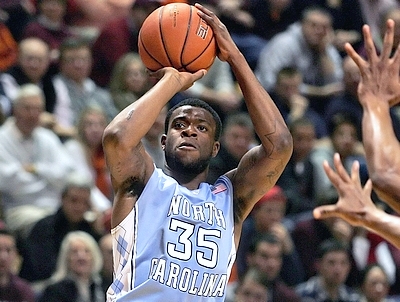
























Comments